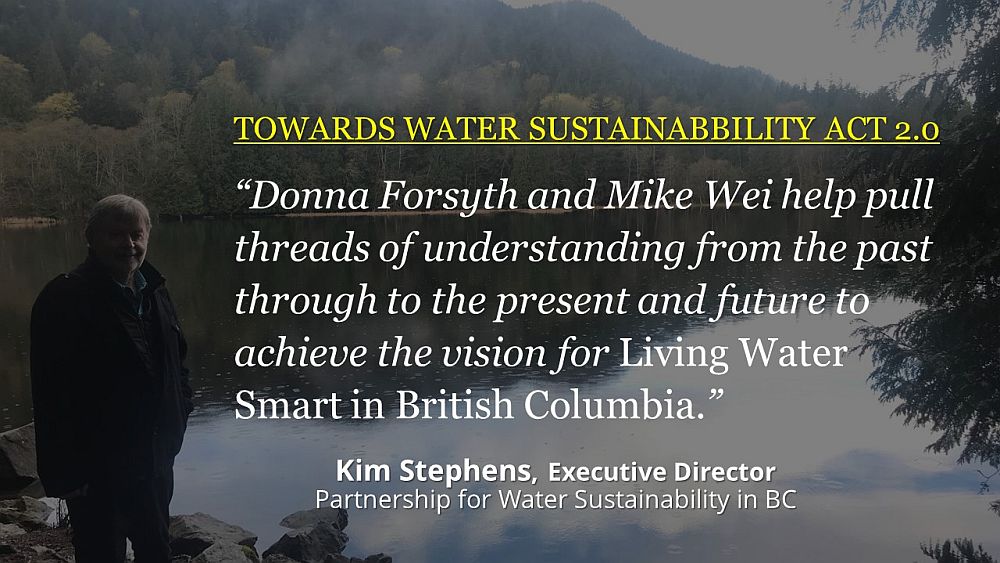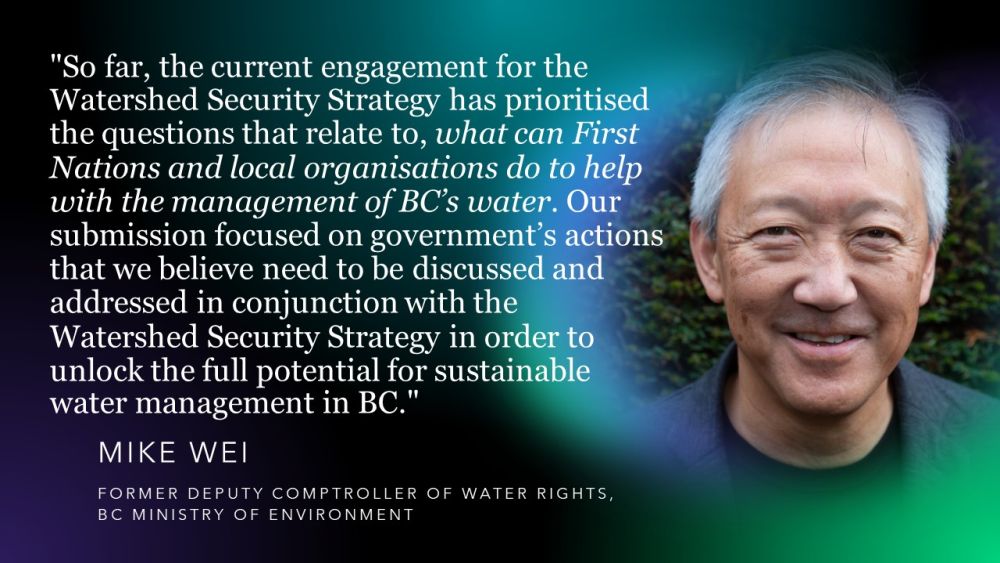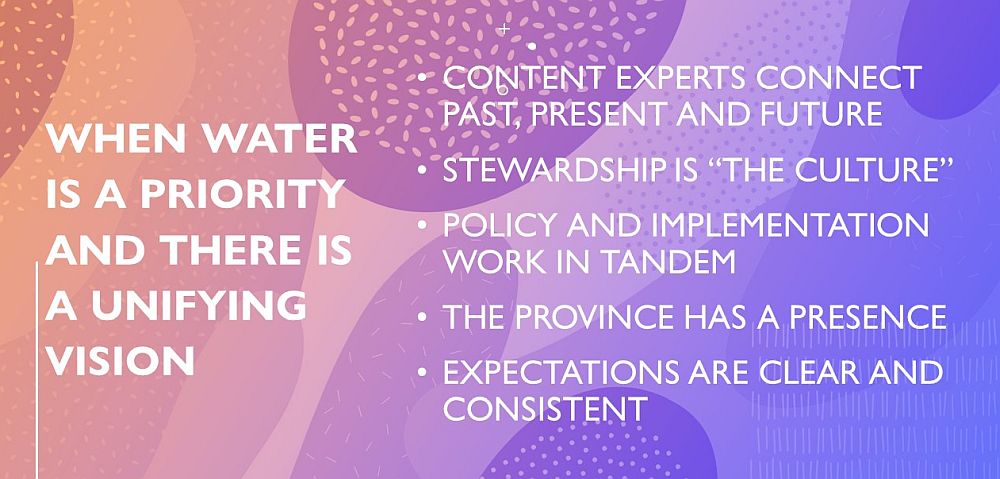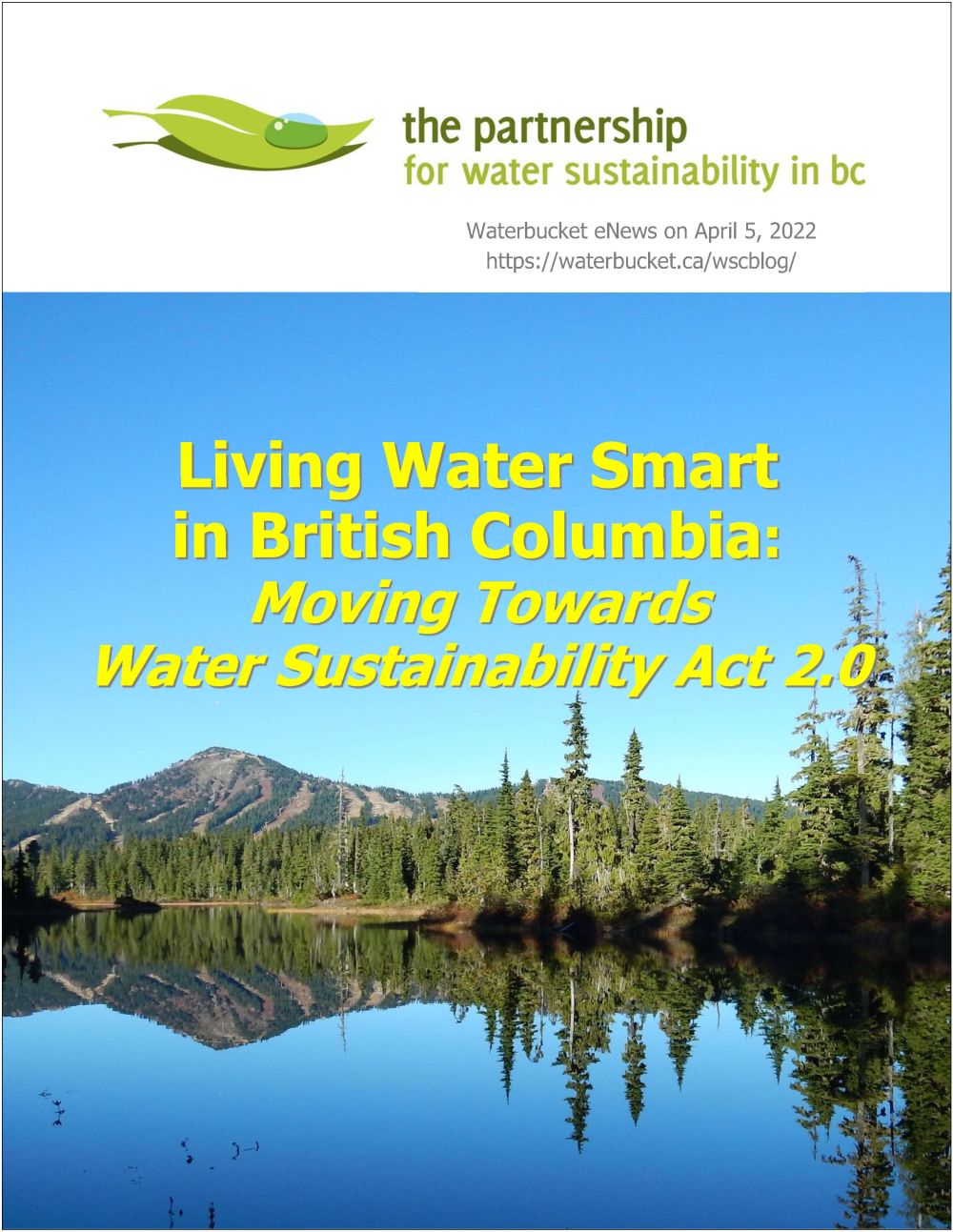LIVING WATER SMART IN BRITISH COLUMBIA: “What might a Water Sustainability Act 2.0 look like? Mike Wei and I identified five challenges and gaps in our submission to the Province of BC that we believe should be front-and-centre in the next round of government priorities,” stated Donna Forsyth, team leader for the drafting of the existing WSA and many of the supporting regulations when she was a legislative advisor to the Ministry of Environment (April 2022)
NOTE TO READER:
Waterbucket eNews celebrates the leadership of individuals and organizations who are guided by the vision for Living Water Smart in British Columbia to build greener communities and adapt to a changing climate; and embrace “design with nature” approaches to reconnect people, land, fish, and water in altered landscapes.
The edition published on April 5, 2022 featured an article by Donna Forsyth and Mike Wei that reflected on challenges and gaps in BC’s Water Sustainability Act, and introduced a framework for addressing them through “WSA 2.0”.
DOWNLOAD A COPY: “Living Water Smart in British Columbia: Moving Towards Water Sustainability Act 2.0″.

What might a Water Sustainability Act 2.0 look like?
Passed by the British Columbia Legislature in 2014, the Water Sustainability Act (WSA) came into force on February 29, 2016. The WSA is once-in-a-generation, transformational legislation. The WSA is the legislative piece of Living Water Smart.
The WSA is not something that the average person thinks about. But in this era of reconciliation, how actions are implemented will have ripple effects that will touch on all our lives. For this reason alone, it is important to “get it right”.
In this edition of Waterbucket eNews, Donna Forsyth and Mike Wei pose the question, what might a Water Sustainability Act 2.0 look like? The article is the prelude to a series. Donna Forsyth and Mike Wei frame the issue in broad-brush terms. In subsequent editions, they will elaborate on five challenges and gaps in the existing WSA, and why they must be reconciled.
In terms of historical context, the original 55 actions comprising Living Water Smart were grouped into five implementation themes. In two of the five – community planning and development; and efficiency, outreach, public awareness – the Partnership for Water Sustainability has played a key delivery role over the years.

Story Behind the WSA Story
Donna Forsyth and Mike Wei bring a firsthand understanding and a clear lens to address the WSA question. Prior to retirement from government, both were senior civil servants in the Ministry of Environment. Mike was the Deputy Comptroller of Water Rights; Donna was a legislative advisor involved in the development of policy. Both were in the room and at the table when the WSA legislation was written.
Donna Forsyth, in fact, led the team tasked with ensuring that the legislation met the policy goals proposed in the consultation on the WSA. She also supported the minister in the Legislature when the bill was debated in 2014. In addition, she coordinated the development of the key regulations required to bring the WSA into force in 2016.
Suffice to say, this duo knows the oral history of how and why decisions were made with respect to the initial content of the WSA. They also offer unique, firsthand knowledge and understanding of the implications of government failing to resolve those challenges and bridge the remaining gaps within the WSA. And what is really important for readers to know, Donna and Mike remain passionate about getting the WSA right. It is their mission.

EDITOR’S PERSPECTIVE
“So, what makes it necessary to draw attention to the need for Water Sustainability Act 2.0 at this very moment? Simply put, it is the Discussion Paper on a Watershed Security Strategy and Fund, released by the provincial government in January. Water is on government’s radar, and this opens the door to asking questions about whether and how government will seize the moment to get it right,” stated Kim Stephens, Waterbucket eNews Editor and Executive Director.
“Viewed in context, the Watershed Security Strategy concept is an important building block in the Living Water Smart process. Therefore, the Partnership for Water Sustainability believes it is also a timely mechanism for the provincial government to revisit, understand, and learn from the “story behind the WSA story”. At the end of the day, however, what actually happens will depend on the provincial government’s willingness to embrace oral history and learn from experience, rather than reinvent the wheel.”
“When each generation, and this includes governments, is receptive to accepting the inter-generational baton and welcoming the wisdom that goes with it, the decisions of successive generations will benefit from and build upon the experience of those who went before them. We will be successful when we achieve better stewardship of BC’s water resources for present and future generations.”
“The Partnership for Water Sustainability has honoured Donna Forsyth and Mike Wei as Ambassadors of the Partnership. This was in recognition of their value-added collaboration with the Partnership in raising the alarm in 2021 about the groundwater licensing crisis. Donna and Mike help pull threads of understanding from the past through to the present and future to achieve the vision for ‘Living Water Smart in British Columbia’.”
“In closing, the emphasis on reconciliation in the Watershed Security Strategy allows us to connect dots. First Nations stress the importance of knowing one’s oral history and passing on the inter-generational baton. If government is to walk the talk regarding water, then shouldn’t the onus be on government to at least learn from its own oral history when it comes to the story behind the WSA story? Continue reading to learn about the wisdom that Donna Forsyth and Mike Wei offer,” concluded Kim Stephens.

What might a Water Sustainability Act 2.0 look like? –“Story Behind the WSA Story” as told by Donna Forsyth and Mike Wei
In January 2022, the Province of BC released its Discussion Paper on a Water Security Strategy and Fund. The ensuing consultation process is an opportunity for the new Ministry of Land, Water and Resource Stewardship to take stock of what has been accomplished through implementation of Living Water Smart Actions and ask, what have we collectively learned in recent years and decades, and what comes next?
In response to this open invitation from the Province of BC, former Ministry of Environment colleagues Donna Forsyth and Mike Wei pooled their knowledge and collaborated to make a joint submission.
Donna Forsyth has a law degree and a BSc in environmental biology. For 13 years she worked for the ministry as a legislative advisor, focusing on water legislation. She was the team lead for the drafting of the Water Sustainability Act (WSA) and many of the supporting regulations. In her role as legislative advisor, she also gained expertise in BC’s oil and gas legislation. Donna retired from government in 2020.
Mike Wei is a professional engineer. He worked 36 years with the Province of BC and was the provincial groundwater program lead. Mike was also a key member of the team that drafted the WSA, the Water Sustainability Regulation and the Groundwater Protection Regulation under the WSA. He is an adjunct member of the University of Victoria’s School of Earth and Ocean Sciences. Mike retired from government in 2018.

Why do Donna Forsyth and Mike Wei care so much about the WSA?
We are dedicated, now retired, public servants. We were part of the team that drafted the Water Sustainability Act (WSA) and regulations – we were “in the room” when the WSA was drafted.
We have intimate knowledge of the WSA and understood that the current WSA represents the first, highest initial priorities written into law and was only the first step in modernising BC’s water legislation.
We are therefore very aware that “certain things were left behind” in the first round and still need to be addressed. For example, under section 5 WSA the provincial jurisdiction over water is limited. There is no jurisdiction for any of the rules under the WSA for water that remains unvested.
So far, the current engagement for the Watershed Security Strategy has prioritised the questions that relate to: “what can First Nations and local organisations do to help with the management of BC’s water”.
Our submission focused on government’s actions that we believe need to be discussed and addressed in conjunction with the Watershed Security Strategy in order to unlock the full potential for sustainable water management in BC. Since climate change is all about water – too much or too little – these changes should fit into climate related initiatives as well.

What were government’s highest priorities when the WSA was brought into force?
First, the WSA finally gave government the authority to require licences for non-domestic groundwater use. Previously the authority to use groundwater was based on the common law concept of “right of capture”, which meant that you could just drill a well and divert the groundwater for use, regardless of the impacts on your neighbours or the environment, including impacts from putting wells right beside water stressed streams,
Secondly, it provided clear legal authority to protect stream flows by considering environmental flows in water allocation decisions.
Thirdly, it addressed the long-standing issues with the First-In-Time-First-In-Right (FITFIR) allocation system by allowing essential household use and critical environmental flow thresholds to take priority above all other uses during a drought. The priorities established under FITFIR could also be modified in water stressed areas through Water Sustainability Plans.
Finally, the new legislation recognized the need for alternative governance arrangements. These options are being explored in pilot projects and are described in the recent Discussion Paper.
Context for the Watershed Security Strategy:
So, we acknowledge the importance of the two tools that the Discussion Paper focused on: the potential for planning and Water Sustainability Plans and the flexible governance options. These tools clearly provide important opportunities to improve water management under the WSA.
However, in our submission it was important for us to ensure that all parties involved in the Watershed Security Strategy engagement are aware of the existing challenges with the implementation of the current WSA. These challenges are connected to the need to address the next round of priorities in WSA 2.0. This additional work will be critical to ensuring the success of the Watershed Security Strategy.
During development of the WSA, the stars appeared to be aligning and everything was pointing to water becoming a real priority for the government. That was our frame of reference in 2014. We believed that the initial version of the WSA would not be the only kick at the can. Given that water is now being recognized as such a big priority, we could say to ourselves: ‘we will be back for WSA 2.0 to deal with the things that we had to leave behind’.

What is the concern about what happened during the post-2016 period?
Before retiring, we observed with concern how, once the WSA was brought into force and the fanfare subsided, the provincial government stopped prioritising the implementation of even the most fundamental piece of this new law which was groundwater licensing.
Remarkedly, responsibility for the implementation of groundwater licensing, the largest water-related undertaking in a century, was not listed in any minister’s mandate letter.
Is it any wonder that we are eager to reach out to the new minister of Land, Water and Resource Stewardship, as well as her staff, and share what we know? At the same time, we also recognize the huge potential benefit of providing this information to any British Columbian interested in water management and engaging with the Watershed Security Strategy process.
Accordingly, our submission for the Discussion Paper engagement process focused on the key insights and background knowledge we gained from being involved with round one of the WSA. We also wanted to provide insight into the follow-up work that we believe will be needed to ensure the success of the Watershed Security Strategy.

|

An over-arching issue is trust:
Completion of all of the above would also go a long way to address the current and widespread lack of trust in the government’s capacity and will to properly manage our water.
That lack of trust exists for many water stakeholders, members of the public, local municipalities and indigenous communities needs to be regained for the WSS to succeed. It will take time and commitment on the part of elected representatives and provincial staff to build the necessary relationships that restore trust and respect.
Clearly, prioritizing the actions described in our submission would demonstrate that the government remains committed to modernizing and implementing BC’s water laws, to allow for the successful protection and management of water in BC, including the initiatives developed under the Watershed Security Strategy.

Did you enjoy this article? Would you like a PDF document version? Click on the image below to download your copy.
DOWNLOAD A COPY: https://waterbucket.ca/wcp/wp-content/uploads/sites/6/2022/03/PWSBC_Living-Water-Smart_Deliver-Outcomes_2022.pdf


